Qualcomm Announces Snapdragon 845 Mobile Platform: Tocks Next-Gen CPU Cores, GPU, AI, & More
by Andrei Frumusanu on December 6, 2017 5:30 PM EST- Posted in
- Mobile
- Snapdragon
- Qualcomm
- Smartphones
- SoCs
- 10nm
- Snapdragon 845

Today as part of its media event, Qualcomm finally announced the much expected Snapdragon 845, successor to last year's very successful Snapdragon 835. The Snapdragon 845 is a large step in terms of SoC architectures as it's the first to employ ARM's DynamiQ CPU cluster organization. Quickly explained, DynamIQ enables the various different CPU cores within an SoC to be hosted within the same cluster and cache hierarchy, as opposed to having separate discrete clusters with no shared cache between them (with coherency instead happening over an interconnect such as ARM's CCI). This major transition is probably the largest to date that we've seen in modern mobile smartphone ARM consumer SoCs.
| Qualcomm Snapdragon Flagship SoCs 2017-2018 | |||
| SoC | Snapdragon 845 | Snapdragon 835 | |
| CPU | 4x Kryo 385 Gold (A75 derivative) @ 2.8GHz 4x256KB L2 4x Kryo 385 Silver (A55 derivative) @ 1.80GHz 4x128KB L2 2MB L3 |
4x Kryo 280 Gold (A73 derivative) @ 2.45GHz 2MB L2 4x Kryo 280 Silver (A53 derivative) @ 1.90GHz 1MB L2 |
|
| GPU | Adreno 630 | Adreno 540 @ 670/710MHz | |
| Memory | 4x 16-bit CH @ 1866MHz LPDDR4x 29.9GB/s 3MB system cache |
4x 16-bit CH @ 1866MHz LPDDR4x 29.9GB/s |
|
| ISP/Camera | Dual 14-bit Spectra 280 ISP 1x 32MP or 2x 16MP |
Dual 14-bit Spectra 180 ISP 1x 32MP or 2x 16MP |
|
| Encode/ Decode |
2160p60 10-bit H.265 720p480 |
2160p30 (2160p60 decode), 1080p120 H.264 & H.265 |
|
| Integrated Modem | Snapdragon X20 LTE (Category 18/13) DL = 1200Mbps 5x20MHz CA, 256-QAM UL = 150Mbps 2x20MHz CA, 64-QAM |
Snapdragon X16 LTE (Category 16/13) DL = 1000Mbps 3x20MHz CA, 256-QAM UL = 150Mbps 2x20MHz CA, 64-QAM |
|
| Mfc. Process | 10nm LPP | 10nm LPE | |
The CPU
The Snapdragon 835's Kryo 280 performance and efficiency cores make use of ARM's Built on ARM Cortex Technology license which allows Qualcomm to make requests to ARM to change some aspects of the architectures of newly released cores and implement these changes exclusively into Snapdragon SoCs. As such the S835's CPU cores were derivatives of ARM's Cortex A73 and Cortex A53 CPU IPs. The Snapdragon 845 being the first SoC to be based on a DynamIQ big.LITTLE CPU organization also undoubtedly suggests that the Kryo 385 CPUs are based on ARM's Cortex A75 and Cortex A55 IPs, as these are the only DynamIQ compatible CPU cores available to date.
The Kryo 385 gold/performance cluster runs at up to 2.8GHz, which is a 14% frequency increase over the 2.45GHz of the Snapdragon 835's CPU core. But we also have to remember that given that the new CPU cores are likely based on A75's we should be expecting IPC gains of up to 22-34% based on use-cases, bringing the overall expected performance improvement to 39-52%. Qualcomm promises a 25-30% increase which is at the low-end of ARM's projections.
The silver/efficiency cluster is running at 1.8GHz, this is clocked slightly slower than the A53's on the Snapdragon 835 however the maximum clocks of the efficiency cluster is mainly determined by where the efficiency curve of the performance cluster intersects. Nevertheless the efficiency cores promise 15% boost in performance compared to its predecessor.
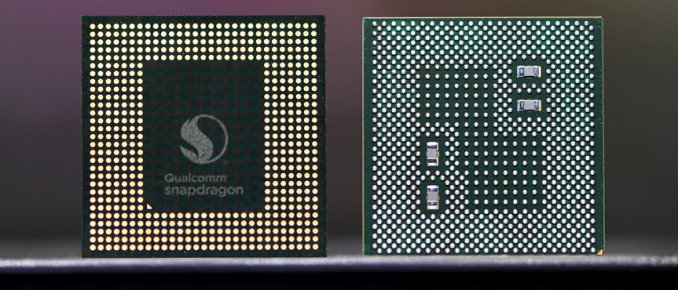
The new Snapdragon 845 now includes capacitors on its package underside
The L3 located on the DynamIQ DSU is configured at 2MB and we're likely seeing 256KB/128KB options for the performance and efficiency core private L2's. Together this would mean there's a total of 3.5MB of combined L2 and L3 cache on the CPU complex.
Qualcomm interestingly disclosed that we're only seeing three voltage and frequency planes implemented; likely meaning a single plane each for the performance cores as well as the efficiency cores as well as a plane for the L3 and DSU. This is surprising as DynamIQ allows finer grained frequency/voltage planes and given Qualcomm being traditionally a big proponent of asymmetric planes such as implemented in Krait I would have expected to see a more non-traditional approach, something that would have been facilitated given the fact that Qualcomm likes to include on-chip LDO regulators for powering the CPU clusters.
Related to the caches but not part of the CPU, there's also a new inclusion of a 3MB system cache. This is likely a SoC interconnect cache and serves all SoC blocks - likely in similar fashion the "L3" cache on Apple A-series SoCs works. This would help reduce external memory transactions and thus also reduce power to the memory controllers and DRAM. Qualcomm claims it's able to reduce memory access bandwidth by up to 40-75%, a significant figure.
The GPU
The Snapdragon 845 comes with a new generation of the Adreno GPU, called the Adreno 630. The switch from a 5xx family to a 6xx family GPU, as with previous introductions from Qualcomm usually marks the transition consisting of larger architectural changes.
Qualcomm is as usual very tight-lipped about details of its GPU but it promises a performance increase of 30% while also increasing power-efficiency by 30%. What this translates to is basically we're looking at 30% higher frame-rates while maintaining the same power consumption of the Snapdragon 835, which is an excellent improvement.
DSP Upgrade to Hexagon 685
The DSP sees a evolutionary upgrade from the 682 to the 685. Again details about the improvements are relatively sparse but Qualcomm promises improvements in power and performance, especially for AI and imaging tasks. Qualcomm made an emphasis on AI processing during the presentation and claim that the new IP achieves up to 3x increase in performance compared to the Snapdragon 835.
Traditional DSP architectures are usually not well optimized for neural network processing so we'll have to adopt a wait & see approach when it comes to the performance of the new Hexagon 685 when executing such tasks. SoCs which have a dedicated NPU such as the Apple A11 or Kirin 970 still have a large edge here as they augment the image processing pipeline instead of handing such tasks over to the DSP which might have to do double duty of both image processing (such as HDR) and image analysis via neural network processing (image recognition and classification).
Snapdragon X20 Modem Now Integrated
As is traditional with Qualcomm we first see cutting-edge modem implementations first released as independent discrete modems and only afterwards do we see them integrated into the newest high-end SoCs. The Snapdragon 845 now integrated the X20 modem released earlier in the year which we've covered in a dedicated article.
The new modem elevates the LTE UE Category to 18 as it's now capable of 5xCA as opposed to 4xCA on the X16 modem integrated in the Snapdragon 835. This allows for download speeds of up to 1.2Gbps when in a 5x20MHz downstream carrier aggregation mode, that is of course, if you're lucky enough for your mobile carrier to support such configurations.
Improved Media Capabilities
The Snapdragon 845's display pipeline receives an upgrade for VR and claims to be now able to drive dual-2400x2400p120 displays for VR headsets. The video recording capabilities have been improved as the Snapdragon 845 increases maximum video encoding framerate at 4K recording from 30 to 60fps compared to the Snapdragon 835. Qualcomm advertised support for Rec.2020 wide gamut color space recording, meaning we now see full support for HDR10 HEVC recording which should be an interesting addition I'm looking forward to test.
The new Spectra 280 ISP's most standout feature seems to be multi frame noise reduction (MFNR) which is a feature that I believe is also used in Google's HDR+ proprietary processing. The feature captures multiple pictures in fast succession and applies an algorithm to apply noise reduction in higher quality fashion compared to traditional single-frame noise reduction which can introduce blurriness.
Manufactured on Second Generation 10LPP Process
The Snapdragon 845 comes manufactured on a second generation 10LPP process from Samsung. This was a natural evolution to be expected as the Snapdragon 835 was manufactured on 10LPE. Samsung promises performance increase of up to 10% at the same power levels or reduced power consumption of up to 15% at the same performance. Samsung had just announced last week the start of mass production for 10LPP. I was rather surprised to see the larger frequency boost to 2.8GHz on the performance cores as the Snapdragon 835 came with rather conservative frequencies of only 2.45. The A75 promised increased performance at the same efficiency, meaning the core uses more power to reach the higher performance point compared to the A73.
Most devices I've seen with Snapdragon 835's used about 1.1W per core at peak using the power virus-style workload we traditionally use so seeing the Snapdragon 845 using the new processor architecture as well as increases in frequency is quite surprising as both would increase the absolute power consumption of the CPUs. The two possible scenarios we're likely to encounter is that either the Snapdragon 845 CPU complex uses more power or that Samsung has managed to vastly improve its manufacturing process over the last year to allow for such gains.
"Tock" Generation For CPU and GPU
The new Snapdragon 845 brings with itself one of the biggest architectural shifts in the ARM SoC space with the first implementation of the new DynamIQ cluster hierarchy. With an expected solid 30% performance boost on both CPU and GPU we're likely to see a healthy upgrade for 2018 flagship devices. Overall the Snapdragon 845 fulfils most of its expectations and in a time in the Android ecosystem where improvements have slowed down this is a good thing. The Snapdragon 835 was an excellent SoC as it balanced performance and power perfectly and thus re-solidified Qualcomm's positioning as the go-to solution for mobile SoCs. On paper the Snapdragon 845 seems to continue this balance and if all goes as planned we're likely to see another healthy generation of devices in 2018 that we're eagerly awaiting to review.


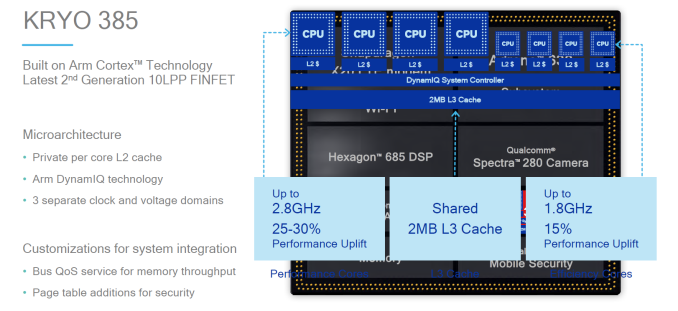
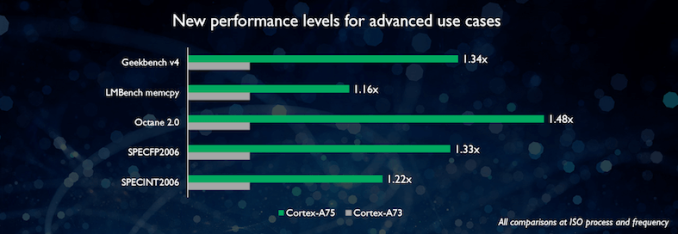
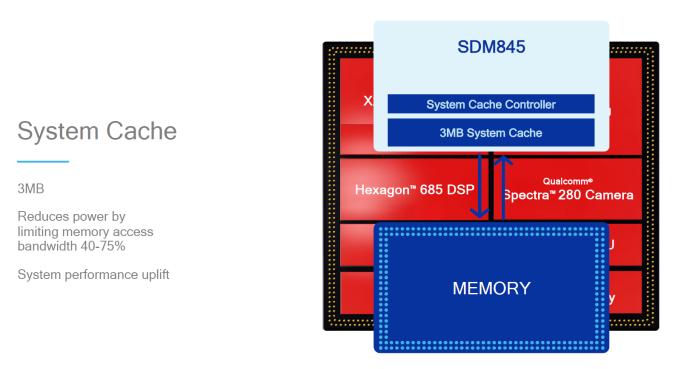
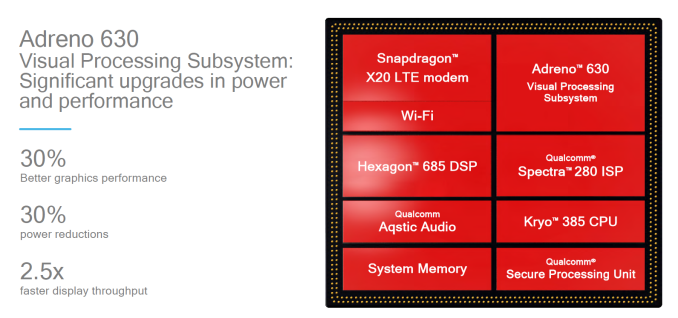

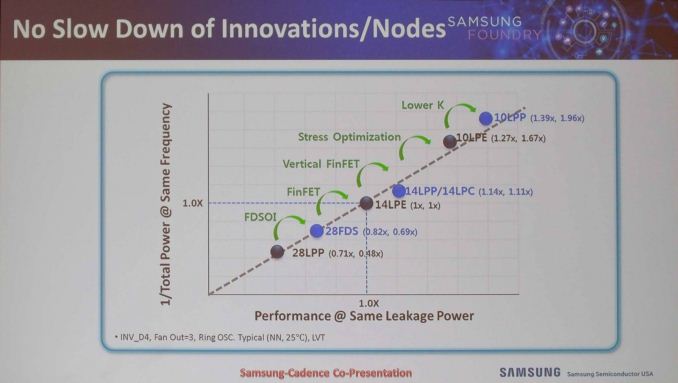








145 Comments
View All Comments
BillBear - Thursday, December 7, 2017 - link
I don't misunderstand a thing.Qualcomm is moving from a present where they can require any payment they like for the use of their CDMA cell phone patents with no FRAND restrictions at all (patents that are absolutely necessary for devices to work with a subset of carriers), to a future where all their patents on cell phone connectivity standards will be FRAND encumbered.
Court rulings over the past decade make it very clear that FRAND encumbered patents can't be used to price gouge, despite the best efforts of some very well heeled tech giants to do exactly that.
Qualcomm will still make a nice, reasonable profit on FRAND encumbered patents that will most likely be set either by the courts or through binding arbitration, but they will no longer be able to make an absolute killing the way their CDMA patent portfolio has allowed.
They have been in a highly profitable position for decades after creating a standard used by a subset of carriers in the days before modern standards bodies would only use FRAND encumbered patents, but as I say, that golden goose is slowly waddling away.
Raqia - Thursday, December 7, 2017 - link
I guarantee you that the legacy CDMA voice standard that's being sunset is not what Qualcomm is making most of its licensing revenues upon nor is it what it's exerting its influence through. It is its 3G and later FRAND patents that are most valuable today and under the most contention. It receives the bulk of these FRAND licensing fees for these but it is through the precedent of hundreds of voluntary licensing agreements that the notion that the contracts are fair is determined, not one or two licensees who are really after deals going into 5G.BillBear - Thursday, December 7, 2017 - link
I guarantee you that the second US carriers sunset CDMA, Samsung will stop using Qualcomm's SOC and modem in the US versions of their phones and use the SOC and modem they produce in-house instead, just like Samsung does in every other nation.Do you imagine that Samsung uses much more expensive parts in the US for some other reason than Qualcomm's ability to hold those CDMA patents over their head?
Raqia - Thursday, December 7, 2017 - link
We're discussing a different issue now, and I agree Samsung has less incentive to use Qualcomm parts once that happens. SoC manufacturing is generally much lower margin for Qualcomm than its licensing business, so it won't lose much margin on Exynos Galaxy phones off which Samsung still owes Qualcomm a royalty. Its SoCs will still have a major edge in modem speed and integration over the Exynos which use an on package modem that incurs more expense than fabbing it on die.BillBear - Thursday, December 7, 2017 - link
That royalty will be a tiny fraction of what Qualcomm is currently able to demand, as they will no longer be legally allowed to charge a percentage of the retail cost of the entire device when they only have FRAND encumbered patents to leverage.Again, this is exactly what Google tried to do to with Microsoft's XBox after Google bought Motorola and the courts smacked Google down.
>According to the ruling, Microsoft will now have to pay Motorola Mobility $0.00555 for each unit it sells incorporating the H.264 standard, and $0.03471 per unit comprising IEEE 802.11 technology. ***Moto had originally argued for a 2.25% cut of the net selling price of the end product*** incorporating its SEP-protected technology. A chart from Microsoft, reproduced at AllThingsD, suggests that Moto’s original demands would have amounted to an annual payout from Microsoft of $4 billion. After Judge Robart’s ruling, Moto will be receiving a comparatively paltry $1,797,554 per year.
http://www.iam-media.com/Blog/Detail.aspx?g=f4a876...
Raqia - Thursday, December 7, 2017 - link
Totally untrue. The royalty will continue to be assessed on a discount schedule off of a fixed fee and this is the same for any phones using Qualcomm's 3G/4G LTE patents. Furthermore, Samsung indeed used its own chips for the S6 but returned to Qualcomm for the S7 and S8; it is interested in dual sourcing for large volume units as well as capital commitments to its capex high foundry business.If you read the details of the Google/Motorola vs Microsoft trial, the issue was that Motorola's patents were vestigial to the standard involved and it was correctly determined that the value added was minimal. Qualcomm's patents are very much seminal and central to 3G and 4G LTE and the value added is substantial as seen from the difference in price in consumer products like iPod vs iPhone or iPad vs iPad LTE.
BillBear - Thursday, December 7, 2017 - link
Absolutely true.Qualcomm has been in the enviable position of having total control of patents that are absolutely necessary to produce a cell phone that will function with the subset of carriers who used CDMA, with no legal restrictions on what they could demand for the use of those patents.
Qualcomm have been demanding (and getting) a percentage of the entire device, because there were no FRAND restrictions to stop them.
Those days are ending the moment that CDMA gets sunset by the carriers and Qualcomm is only left with FRAND encumbered patents covering cellular connectivity that they leverage.
No more demanding a percentage of the cost of the entire device.
Additionally, Samsung and Apple both show every sign that they will kick Qualcomm to the curb the moment they have to kiss the ring in exchange for access to those CDMA patents.
Qualcomm needs to be thinking about where it's future high revenue streams are going to come from, because that golden goose is slowly waddling away.
Raqia - Thursday, December 7, 2017 - link
What's not FRAND about that? The standard fee they assess is capped at around $10 for 3G/4G LTE, and if your bill of materials is under $300, they'll give you a discount. (5G licensing is similar, you can check on their website for the details.) It will clearly be an OEM's goal to maximize their own margins and characterize the fee schedule as a undeserved cut into technologies that have nothing to do with Qualcomm when in reality it's more of a discount.Dunno about you but I live where museums, theaters, and amusement parks give children, seniors and students a discount and it's done in the name of fairness. Income tax schedules are even progressive, not just proportional also in the name of fairness. Qualcomm gives manufacturers of cheaper phones a discount on the technology needed to participate in the networks they enable, and this is fair since it enables new entrants and competition in the cell phone market.
BillBear - Thursday, December 7, 2017 - link
Are you under the impression that it's your job to prop up Qualcomm's stock price? It sure seems that way.Qualcomm faces major changes in their market position that are going to severely cut into their profit margins in the not so distant future when CDMA is sunset by the carriers and they are left with only FRAND encumbered patents on the basic cellular connectivity every device requires.
That doesn't mean they won't still get a fair and reasonable royalty on their patents that are part of the LTE standard, but the price gouging and it's associated exceptionally high profit margins will end.
Just as Google saw it's demand that Microsoft pay four billion dollars for using FRAND encumbered patents in the XBox reduced to a payout of less than two million dollars by the courts, Qualcomm will no longer be legally allowed to price gouge when it only has FRAND encumbered patents to rely on.
Server chips are a high margin business and Qualcomm's server chip looks pretty good for a first revision, so it behooves Qualcomm to keep up it's investment in that area if they are thinking about the future and Intel waking from it's slumber.
Raqia - Thursday, December 7, 2017 - link
Well it's also not like Steve Jobs put on a turtleneck and said: "...one more thing: we're suing Qualcomm," and I just think far too many people buy the distortive comments by Apple at face value. They made next to no investments into standards and rode licensing past prior top phone makers in just a few years. I also think it's up to the market to determine what a fair rate is rather than a single self interested licensee who has a habit of stealing IP and is not honoring contracts. The patents involved in Qualcomm's dispute are worth far more than those in the Motorola dispute if valued w/ similar methodologies as was employed in the Motorola dispute so I think the outcome for Qualcomm in a similar trial would be quite different. Qualcomm is rather aggressive in monetizing its patents and definitely not a good guy, but I think in recent disputes Apple is behaving far more badly.